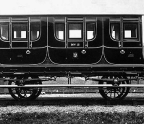
The Liverpool & Manchester Railway was the first modern main line railway, both in concept and operation. It was colloquially known as the ‘Grand Experimental Railway’ and to a point this was true – no-one had attempted to run a main line railway to a timetable between two urban centres, with mechanical traction before. Earlier railways had tended to be uni-directional in terms of traffic flow, from pit head or quarry to staithes or landsale wharf, and used a mix of mechanical (locomotive and stationary engines) and animal (usually horse) traction. As the present writer has described, 1 that the L&M got so much right operationally from day one – in fact it had to – is a testament to the organisational flare of men like Henry Booth, the line’s general manager.2 Lessons were quickly learned, especially in terms of motive power: the type of locomotive which had succeeded so triumphantly at Rainhill was within twelve months obsolete. Thanks to Robert Stephenson&Co. of Forth Street, Newcastle, having no test facilities of its own, the L&M became a veritable test track and laboratory for the locomotive, with each new idea and design of Robert Stephenson and his team being worked out practically in service on the L&M. Sadly this practical experiment often resulted in accidents and fatalities from component failure, notably of wheels and axles, until a robuster design could be found.
The L&M board was open to any and all suggestions to improve the working and efficiency of its railway, both from members of the public and its own staff: a design of multitubular boiler suggested by Joseph Locke was examined by the Board in September 1832, whilst John Dixon essayed a novel form of valve gear using “a steam cylinder and piston, immediately above the slide and connected therewith by a rod” to work the valves in order to relieve them “from the very heavy steam pressure on the slides”.3 The board would continue to support – and reward – its employees inventiveness, including its Locomotive Foreman, John Melling, or John Grey whose designs were taken seriously by the board and given a full and fair trial, in the case of Melling even full adoption of several of his patented ‘improvements.’4
It was against this background of innovation and experimentation that many established engineers proposed to build their own locomotives for trial and, if things went well, eventual use on the L&M. In May 1831, in order to “obtain the most improved Locomotive Engine that mechanical skill and experience can furnish”, the Directors of the Liverpool & Manchester advertised tenders for “locomotives equal or superior to the best at present in use … on the Line”. Expressions of interest came from Sharp, Roberts & Co.of Manchester; Edward Bury of the Clarence Foundry in Liverpool, George Forrester of the Vauxhall Foundry, Liverpool, and William Fairbairn of Manchester. Messrs. Galloway, Bowman & Glasgow of Manchester also rose to the challenge and it was they, together with Sharp, Roberts & Co.who built the first locomotives in Manchester.
Manchester had an enviable reputation in the nineteenth and twentieth century as a locomotive building centre, being the home of Beyer, Peacock & Gorton (1854-1968), Richard Roberts & Co. (later Sharp Stewart & Co.) (1828-1888 when they removed to Glasgow), William Fairbairn & Sons (18161864 when the locomotive business was sold), Nasmyth, Gaskell & Co. (latterly Nasmyth Wilson) (1836-1940). However, the first locomotive built in Manchester was not erected by any of these luminaries, rather that honour falls to Galloway, Bowman &




